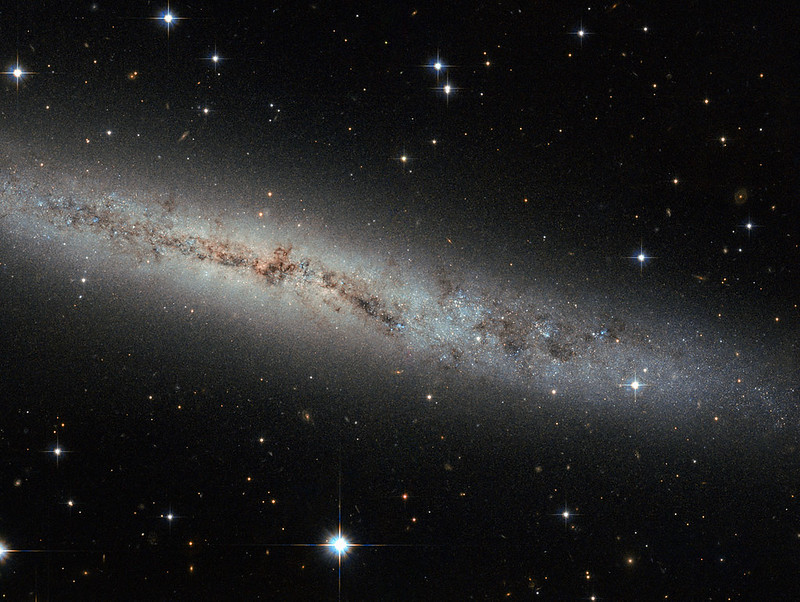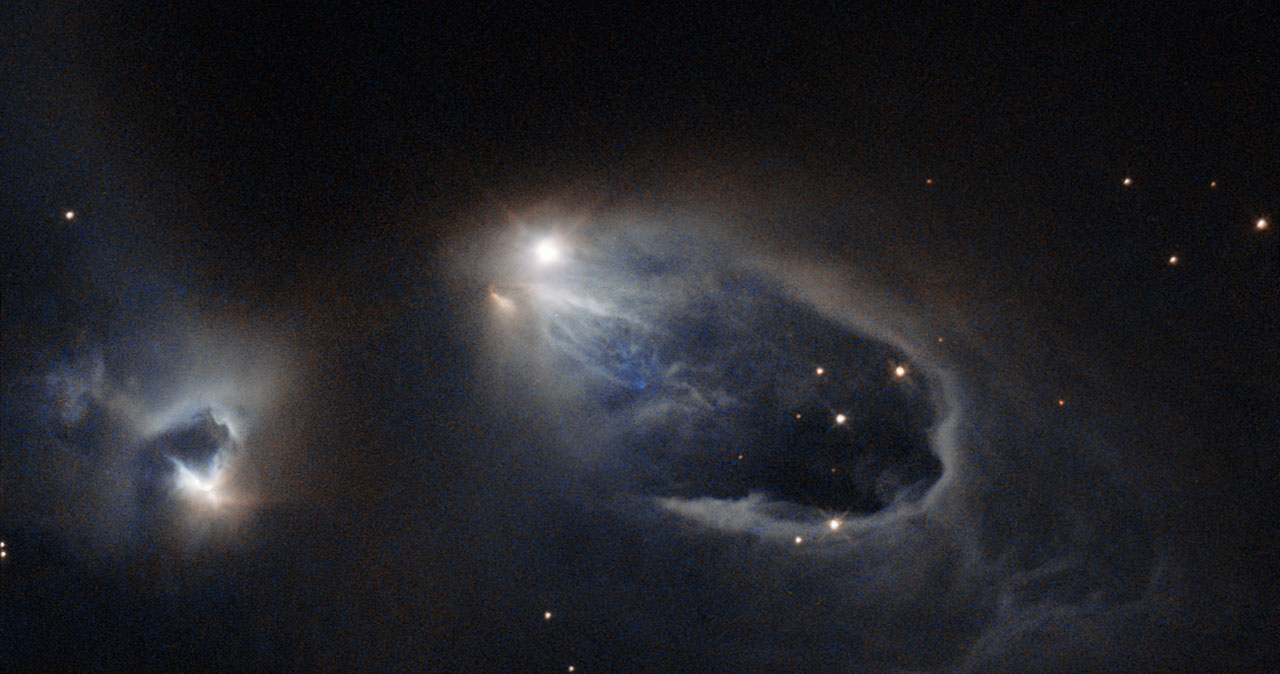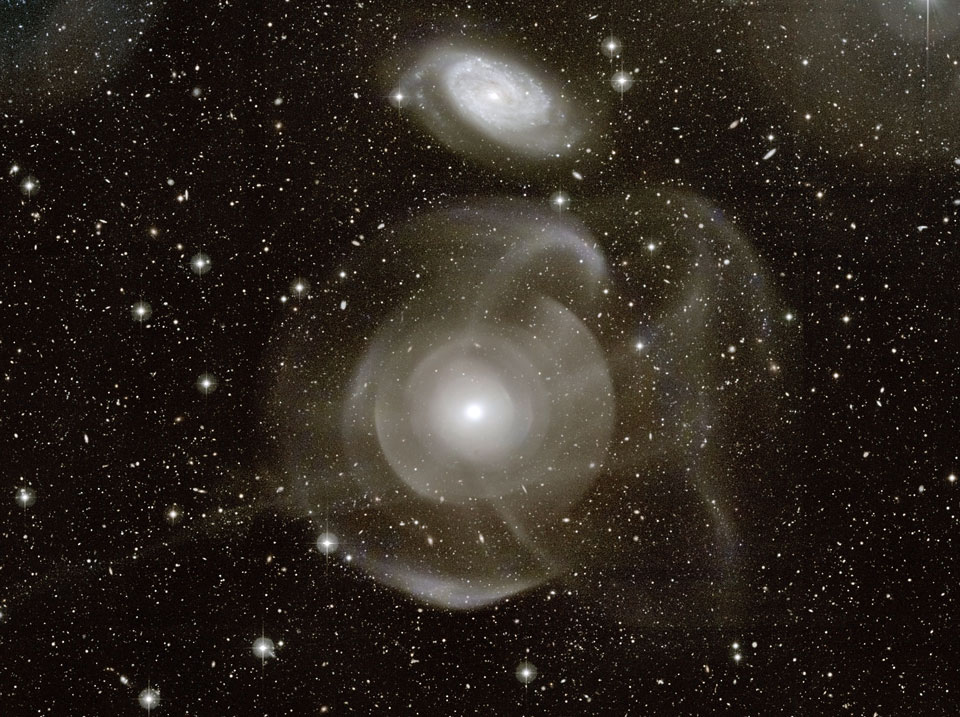Welcome to DU!
The truly grassroots left-of-center political community where regular people, not algorithms, drive the discussions and set the standards.
Join the community:
Create a free account
Support DU (and get rid of ads!):
Become a Star Member
Latest Breaking News
General Discussion
The DU Lounge
All Forums
Issue Forums
Culture Forums
Alliance Forums
Region Forums
Support Forums
Help & Search
Science
Related: About this forumA couple of beauties from Hubble (big images)

Located some 25 million light-years away, this new Hubble image shows spiral galaxy ESO 373-8. Together with at least seven of its galactic neighbors, this galaxy is a member of the NGC 2997 group. We see it side-on as a thin, glittering streak across the sky, with all its contents neatly aligned in the same plane.
We see so many galaxies like this — flat, stretched-out pancakes — that our brains barely process their shape. But let us stop and ask: Why are galaxies stretched out and aligned like this?
Try spinning around in your chair with your legs and arms out. Slowly pull your legs and arms inwards, and tuck them in against your body. Notice anything? You should have started spinning faster. This effect is due to conservation of angular momentum, and it’s true for galaxies, too.
This galaxy began life as a humungous ball of slowly rotating gas. Collapsing in upon itself, it spun faster and faster until, like pizza dough spinning and stretching in the air, a disc started to form. Anything that bobbed up and down through this disk was pulled back in line with this motion, creating a streamlined shape.
Angular momentum is always conserved — from a spinning galactic disk 25 million light-years away from us, to any astronomer, or astronomer-wannabe, spinning in an office chair.
Credit: NASA
http://www.flickr.com/photos/gsfc/11648639246/

Look at the bright star in the middle of this image. It appears as if it just sneezed. This sight will only last for a few thousand years — a blink of an eye in the young star's life.
If you could carry on watching for a few years you would realize it's not just one sneeze, but a sneezing fit. This young star is firing off rapid releases of super-hot, super-fast gas, like multiple sneezes, before it finally exhausts itself. These bursts of gas have shaped the turbulent surroundings, creating structures known as Herbig-Haro objects.
These objects are formed from the star's energetic "sneezes." Launched due to magnetic fields around the forming star, these energetic releases can contain as much mass as our home planet, and cannon into nearby clouds of gas at hundreds of kilometers/miles per second. Shock waves form, such as the U-shape below this star. Unlike most other astronomical phenomena, as the waves crash outwards, they can be seen moving across human timescales of years. Soon, this star will stop sneezing, and mature to become a star like our sun.
This region is actually home to several interesting objects. The star at the center of the frame is a variable star named V633 Cassiopeiae, with Herbig-Haro objects HH 161 and HH 164 forming parts of the horseshoe-shaped loop emanating from it. The slightly shrouded star just to the left is known as V376 Cassiopeiae, another variable star that has succumbed to its neighbor's infectious sneezing fits; this star is also sneezing, creating yet another Herbig-Haro object — HH 162. Both stars are very young and are still surrounded by dusty material left over from their formation, which spans the gap between the two.
Credit: ESA/Hubble & NASA, Acknowledgement: Gilles Chapdelaine
http://www.flickr.com/photos/gsfc/11467249715/
InfoView thread info, including edit history
TrashPut this thread in your Trash Can (My DU » Trash Can)
BookmarkAdd this thread to your Bookmarks (My DU » Bookmarks)
11 replies, 3619 views
ShareGet links to this post and/or share on social media
AlertAlert this post for a rule violation
PowersThere are no powers you can use on this post
EditCannot edit other people's posts
ReplyReply to this post
EditCannot edit other people's posts
Rec (45)
ReplyReply to this post
11 replies
 = new reply since forum marked as read
Highlight:
NoneDon't highlight anything
5 newestHighlight 5 most recent replies
= new reply since forum marked as read
Highlight:
NoneDon't highlight anything
5 newestHighlight 5 most recent replies
A couple of beauties from Hubble (big images) (Original Post)
n2doc
Jan 2014
OP
I like the first one better. Wow! 25 million light years away. Mind blowing!
Auntie Bush
Jan 2014
#6
2naSalit
(86,636 posts)1. Those are cool! n/t
cinnabonbon
(860 posts)2. These are amazing
I could stare at the second one for ages.
Auntie Bush
(17,528 posts)6. I like the first one better. Wow! 25 million light years away. Mind blowing!
hue
(4,949 posts)3. Thanks for posting!! Beautiful!!
Bernardo de La Paz
(49,002 posts)4. If you like stuff like this in little bites see APOD every day
Astronomy Picture Of the Day:
http://apod.nasa.gov/apod/astropix.html
Here's today's picture in reduced form; go to the link for higher res.

Aldo Leopold
(685 posts)5. Wow. Love it!
7wo7rees
(5,128 posts)7. Gesundheit!

yuiyoshida
(41,831 posts)8. I just wanta go out there!

NastyRiffraff
(12,448 posts)9. Oh man, those are breathtaking!
But...but...The Earth is the center of the universe! And the Sun revolves around it. ![]()
I love Hubble.
oldandhappy
(6,719 posts)10. Beautiful!
Thank you, lots.
packman
(16,296 posts)11. Beautiful and humbling
There are more things in heaven and earth, Horatio,
Than are dreamt of in our philosophy.